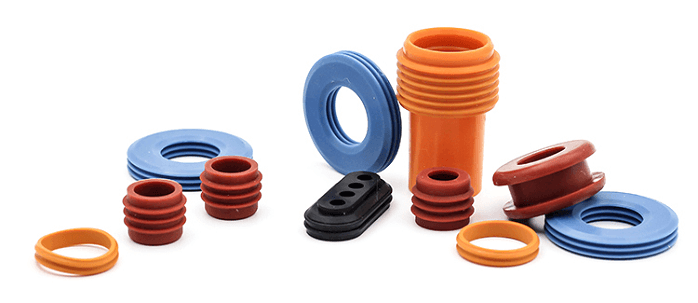The Main Differences between Fluorosilicone and Silicone Rubber
2022-02-01
Every single rubber compound features its own distinctive properties which makes it a good choice to obtain a specific application. And for silicone and also FVMQ fluorosilicone rubber, although these are related in properties, Fluorosilicone is nearly 5 times high priced than silicone rubber materials. Here are 2 important differences for the 2 rubber compounds.
1 - Breaking Down the Mechanical Differences
Silicone is produced from silicon, hydrogen as well as o2 as well as is known for its flexibility at extreme temperature as well as small compression set features. The working mechanical properties of silicone include:
• Temperature resistance of regular compounds range between -85°F to 400°F
• Stable in excessive temp surroundings
• Hardness ranges from 20 to 80 Shore A
• Works with FDA regulations
Fluorosilicone gives you the exceptional heat amount of resistance and steadiness properties of silicone. However, the two rubbers differ in that fluorosilicone offers supplemental added benefits and slightly diverse mechanical properties which makes it a desired elastomer for several industries. These types of properties contain:

• Temp resistance of common compounds range from -75°F to 400°F
• Delivers exceptional resistance to weather condition and ozone
• Protected from fuel, oil, solvent and water
• Hardness ranges from 40 to 80 Shore A
Either silicone and fluorosilicone are restricted by their poor abrasion level of resistance and also high rubbing characteristics. Because of these kind of limitations, they are really not recommended for dynamic sealing. Furthermore, both rubbers will not be suitable for contact with ketones.

2 - Recommended Applications for Silicone and Fluorosilicone
On account of its compatibility with FDA regulations, silicone is a top option material for those health care market. In addition to medical purposes, silicone can also be found in the automobile, aerospace and electronic products industries. Usual applications for silicone involve:
• Electric powered products seals in cockpits, automotives as well as professional medical equipment
• Professional medical pumping systems, ventilators, IV components as well as feeding devices
• Engine gaskets as well as petrol turbine seals
• Hydraulic seals
The distinct proof properties of fluorosilicone allow it to be the top selection for the aerospace marketplace, as well as engine oil and gasoline applications. In the same manner to silicone, fluorosilicone is often molded into o-rings, gaskets, piping and other seals. Fluorosilicone is suggested for the adhering to purposes:
• Automatic gasoline emissions command systems
• Chlorinated solvent conditions
• Petroleum oil programs
• Jet fuel programs
The two silicone and fluorosilicone should be utilised in static seal programs. To learn more about the chemical compatibilities of silicone and fluorosilicone.
1 - Breaking Down the Mechanical Differences
Silicone is produced from silicon, hydrogen as well as o2 as well as is known for its flexibility at extreme temperature as well as small compression set features. The working mechanical properties of silicone include:
• Temperature resistance of regular compounds range between -85°F to 400°F
• Stable in excessive temp surroundings
• Hardness ranges from 20 to 80 Shore A
• Works with FDA regulations
Fluorosilicone gives you the exceptional heat amount of resistance and steadiness properties of silicone. However, the two rubbers differ in that fluorosilicone offers supplemental added benefits and slightly diverse mechanical properties which makes it a desired elastomer for several industries. These types of properties contain:

• Temp resistance of common compounds range from -75°F to 400°F
• Delivers exceptional resistance to weather condition and ozone
• Protected from fuel, oil, solvent and water
• Hardness ranges from 40 to 80 Shore A
Either silicone and fluorosilicone are restricted by their poor abrasion level of resistance and also high rubbing characteristics. Because of these kind of limitations, they are really not recommended for dynamic sealing. Furthermore, both rubbers will not be suitable for contact with ketones.

2 - Recommended Applications for Silicone and Fluorosilicone
On account of its compatibility with FDA regulations, silicone is a top option material for those health care market. In addition to medical purposes, silicone can also be found in the automobile, aerospace and electronic products industries. Usual applications for silicone involve:
• Electric powered products seals in cockpits, automotives as well as professional medical equipment
• Professional medical pumping systems, ventilators, IV components as well as feeding devices
• Engine gaskets as well as petrol turbine seals
• Hydraulic seals
The distinct proof properties of fluorosilicone allow it to be the top selection for the aerospace marketplace, as well as engine oil and gasoline applications. In the same manner to silicone, fluorosilicone is often molded into o-rings, gaskets, piping and other seals. Fluorosilicone is suggested for the adhering to purposes:
• Automatic gasoline emissions command systems
• Chlorinated solvent conditions
• Petroleum oil programs
• Jet fuel programs
The two silicone and fluorosilicone should be utilised in static seal programs. To learn more about the chemical compatibilities of silicone and fluorosilicone.

